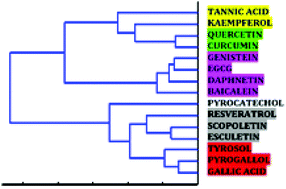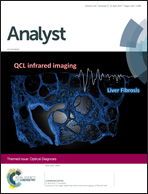HTS-FTIR spectroscopy allows the classification of polyphenols according to their differential effects on the MDA-MB-231 breast cancer cell line†
Abstract
Breast cancer is a major public health issue among women in the world. Meanwhile new anticancer treatments struggle more and more to be accepted in the pharmaceutical market and research costs still increase. There is therefore a need to find new treatments and new screening methods to test them more quickly and efficiently. Among natural compounds, an increasing interest has been given to polyphenols as they can take action at the different stages of carcinogenesis, from tumour initiation to metastasis formation, by disturbing multiple cellular signalling pathways. They constitute one of the largest groups of plant metabolites and more than 8000 compounds have already been identified based on their chemical structure. Traditionally in pharmacology, new anticancer drugs are first evaluated for their potential to inhibit the proliferation of cancer cell lines. Numerous potential drugs are discarded at this stage even though they could show interesting modes of action. In turn, there is an increasing demand for more systemic approaches in order to obtain a global and accurate insight into the biochemical processes mediated by drugs. Recently, FTIR spectroscopy was demonstrated to be an innovative tool to obtain a unique fingerprint of the effects of anticancer drugs on cells in culture. While this spectral technique appears to have a definite potential to sort drugs according to their spectral fingerprints, characteristic of the metabolic modifications induced, the present challenge remains to evaluate the drug-induced spectral changes in cancer cells on a larger scale. This article presents the results obtained for a 24 h-exposure of the breast cancer cell line MDA-MB-231 to 15 compounds belonging to different classes of polyphenols using FTIR spectroscopy connected to a high throughput screening extension. Through unsupervised and supervised statistical analyses (PCA, MANOVA, Student's t-tests and HCA), a distinction between polyphenol treatments and controls could be well established.

- This article is part of the themed collection: Optical Diagnosis


 Please wait while we load your content...
Please wait while we load your content...